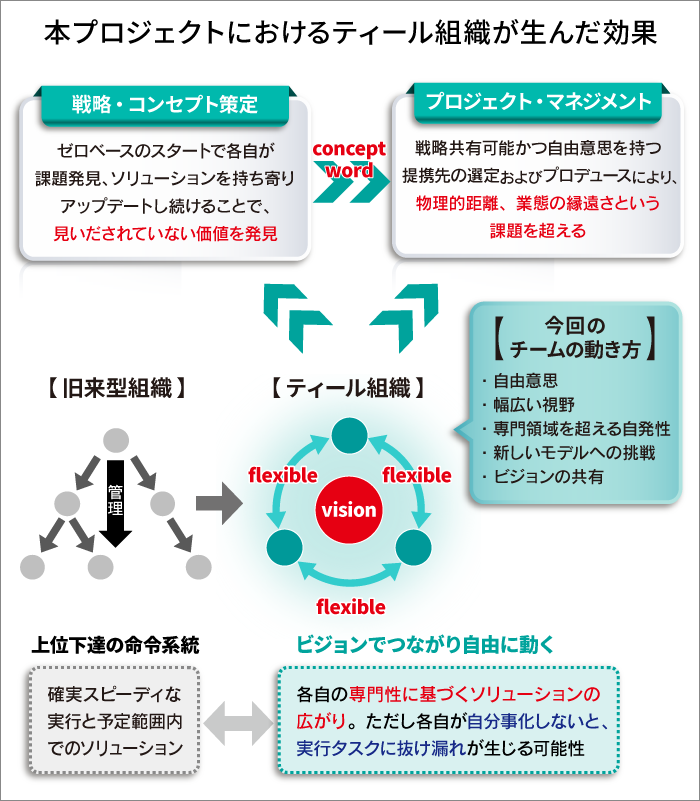In October 2019, BEAMS Japan in Shinjuku launched collaborative products between young Ainu artisans from Lake Akan Onsen, Hokkaido, and the BEAMS label <fennica>, a select shop continuously introducing handcrafts from across Japan. Part 1 of this series introduced business models like "local production, external sales" and "transforming tourist destinations into places of exchange," along with motivation-building for sustainably advancing projects.
Part 2 examines the value that the Ainu culture we encountered presents to modern society—a "hint for the future"—and how recognizing this value was linked to societal demand, leading to the development of collaborative products. We explore this from an organizational theory perspective, focusing on the "team driven by free will = Teal organization."
Encountering the "Ainu Culture" as a Different Culture
What comes to mind when you hear "Ainu"? I had previously seen patterns resembling Ainu designs in souvenir shops, but my impression was merely "unique," and I had no further contact or deeper understanding afterward.
When launching the Lake Akan regional revitalization project, I recalled these patterns. Through conversations with Ainu people, I learned their distinctive designs—used in woodcarvings—serve as talismans against evil. When embroidered on kimonos, they are stitched with the wearer or user in mind. These unique characteristics of Ainu ethnicity and culture convinced me they held compelling potential.
At the same time, I had an initial intuition that incorporating Ainu crafts into everyday life might be difficult due to the strong individuality of the patterns. We set the goal of "local production for external sales." We aimed to develop products with universal value—not just souvenirs bought as travel mementos—but items where someone might think, "This is nice," and discover it was Ainu craft. We wanted to create connections with people outside the target region through a fresh presentation, moving beyond the image of "the good old days of Ainu."
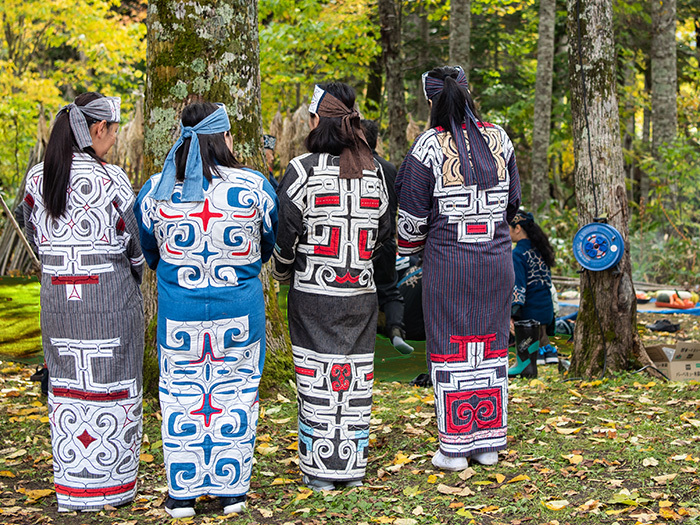
Kimono adorned with traditional Ainu patterns
A modern bible?! The Ainu people, ahead of the SDGs
As our interactions deepened, what struck us most was the Ainu people's attitude of coexisting with nature. Their teachings hold that Kamui (gods) reside in all animals, plants, and even tools. They had a custom of raising cubs alongside their captured mother bears without killing them until the cubs grew up. When gathering plants for weaving materials like clothing or baskets, they say "I receive this," and traditions passed down emphasize "having a grateful heart" and "not uprooting everything when gathering," ensuring life is not needlessly extinguished.
Moreover, while many traditional crafts in Japan are disappearing due to a lack of successors, I heard that Ainu handicrafts are naturally passed down through generations as part of daily life. Stories like "I learned embroidery from my grandmother" or "I went gathering materials with my aunt" are common. This is a people who inherently know how to value nature and objects. I felt this approach is ahead of the SDGs.
In this way, I sensed that the Ainu society's way of thinking and living holds hints for the future—for reclaiming what modern people have lost and living strongly. My perspective shifted, seeing it as a kind of "modern-day bible."
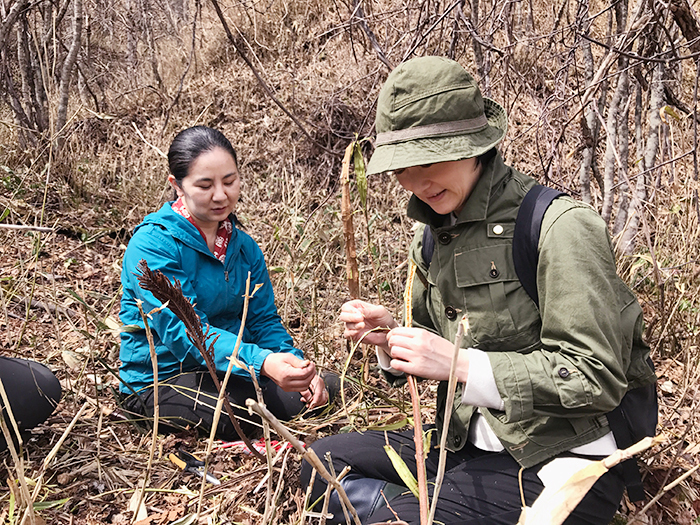
Collecting "Japanese honeysuckle" for craft materials
"Living with Lake Akan" is the core of the brand story
My first visit to Akan Lake Hot Springs was nearly two years before the enactment of the new Ainu law. It was early autumn 2017. While savoring the rich natural surroundings and exploring the area, I visited several souvenir shops and workshops in one of Hokkaido's most prominent Ainu Kotan (villages/settlements), seeking possibilities for collaboration. Among the seemingly similar product offerings, I encountered several pieces that truly resonated with me. Fortunately, I gained the consent of their creators to participate, bringing together young artisans skilled in wood carving, embroidery, weaving, and metal engraving.
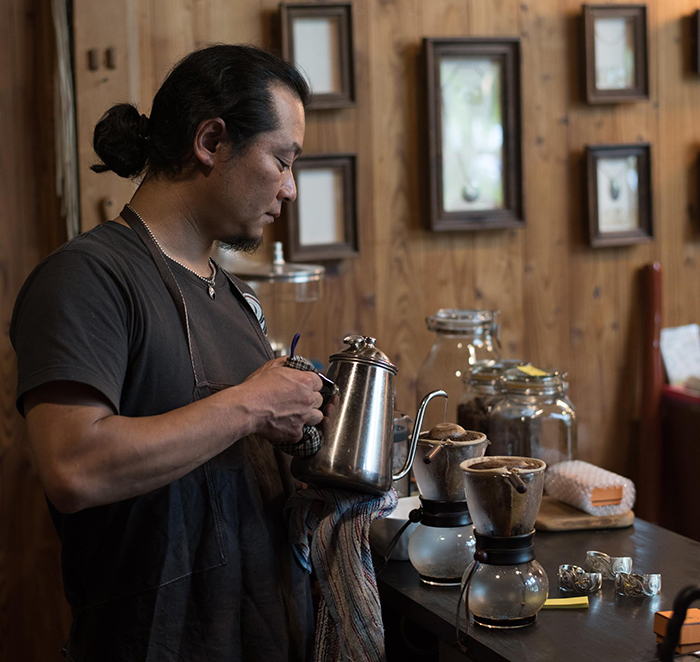
A metal engraving artist who runs a cafe within their workshop
From the very first day we met, it became clear that it wasn't just the flavor of their work, but their captivating personalities and the unique environment of Lake Akan—surrounded by forest and lake—that underpinned the individuality of the Akan Lake Ainu people. I sensed a strong premonition that this would evolve into a solid brand. Lake Akan Onsen has a distinctive history of pioneering cultural outreach—establishing an Ainu dance theater and employing guides in traditional attire on sightseeing boats—positioning it not merely as a guardian of tradition but as an "open Ainu" community.
These insights led me to envision building the brand around the core of the artist's lifestyle and persona, alongside the products we develop. To delve into the artist's inner world, we invited a writer from an Ainu Kotan, raised within Ainu culture, to participate. We launched the website " kar pe kuru ~ The Town of Creators, Akanko Onsen " six months before the product release to lay the groundwork. At launch, we solidified the brand's core by linking the artist's profile with their work and providing detailed introductions.
The unexpected success born from a "Teal organization" that moves freely and connects through vision
We believe the key to Dentsu Inc. producing this project beyond its core strengths in branding and promotion was the freedom of teaming. The team consisted of three members who happened to sit next to each other years ago but were now working in different departments on different missions. We brought diverse expertise: sales, strategic planning, publishing, content, HR, and corporate planning. Later in the project, members from Dentsu Hokkaido Inc. joined us, advancing the project together.
While the next-generation organizational model "Teal Organizations" is gaining attention in the business world, we also progressed organically without predefined roles. Each member proactively applied their distinct expertise. We constantly confronted fundamental issues, identified challenges from multiple perspectives, and sometimes crossed boundaries to clash ideas and generate solutions, thereby achieving individual skill development.
While SDGs often highlight corporate and municipal activities, we focused on the traditional way of life passed down by the Ainu people, viewing it as "a bible offering hints for our future." To create previously unseen solution points, this broad perspective and approach based on free will proved essential.
Furthermore, starting from scratch meant conventional approaches wouldn't work. Flexible thinking was essential for tackling the challenges of bridging the physical distance between Tokyo and Lake Akan, and the disparity between the Ainu people and the select shop business model.
In a self-managed Teal organization, where decisions aren't top-down, the "vision" – the project's direction and goals – becomes the sole rule defining members' freedom of action. Sharing the vision and embracing freedom to adapt. Ideally, these are developed further collectively through ongoing activity.
Vision is also crucial for flexible structures involving diverse players
The project connected young Ainu craft artists active in Akan Lake Hot Springs with <fennica>, a label under the select shop BEAMS (directed from London) that continuously introduces handmade crafts from across Japan to the market. While we connected these two groups who would not normally have met, flexible collaboration made it possible—not just with internal members, but also with the Akan Lake Onsen Tourism Association, Kushiro Shinkin Bank, local coordinators, and Ainu writers. The presence of a shared vision was undoubtedly crucial here.
On the first day of the Akan visit, fennica director Keiko Kitamura stated: "Japan's traditional crafts face extinction across the country. Even without direct successors, there are still people who observed the craft up close or once handled it – we're at the last possible moment. Once a technique is lost, it's gone forever. We feel a sense of mission: we must protect these wonderful skills, and we must act now."
She is the person who revived Sendai's traditional kokeshi dolls by updating them as "Indigo Kokeshi," sparking a "kokeshi boom" where female collectors, known as "kokeshi girls," lined up before the release. Her words were compelling. While this philosophy aligns with fennica's original mission, it ultimately became our motivation, integrated into the project vision, and embraced by the entire team.
Recommendations for Developing Concept Words to Motivate Teams Through Free Will
Words proved highly effective in managing the Teal organization. From the outset, we distilled the project vision and worldview into concept words and used them intentionally. We leveraged the fact that we were starting from scratch, constantly setting ambitious goals for the project. "Lake Akan Next Generation" was one such concept. As part of the artists' branding, the goal was to position them not merely as young talents, but as the next generation inheriting the legacy of Lake Akan—a place that has historically produced master woodcarvers like Masamitsu Takiguchi, Takeki Fujito, and Nuburi Tokonuma—and to leverage the region's cultural assets.
The working title "AKAN AINU Collection," used internally from the start, embodied our vision: to create a collection of items that evoke the distinctiveness of Akan Lake's Ainu culture, spark desire to collect them, and establish a lasting brand, not a fleeting one. It also aimed for an image distinct from typical souvenirs, blending artistic quality with lifestyle appeal.
These concepts were carried forward into the title of the "New Collection" launch event by fennica director Terry Ellis: "AINU CRAFTS from Lake Akan Tradition and Innovation." Over two years, the members' vision evolved through shared language, eventually taking tangible form.
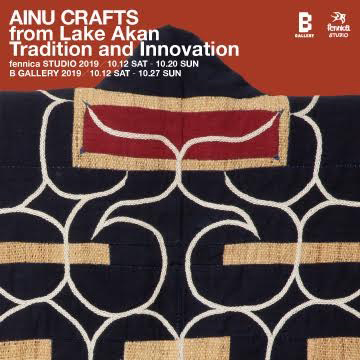
Event Key Visual




